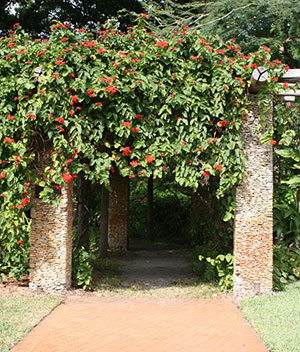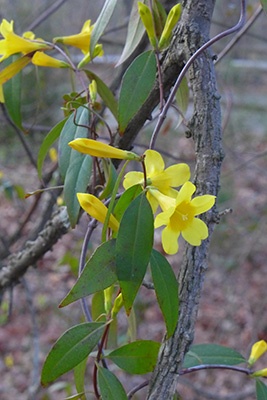Versatile Vines

Vines can add a new dimension to the Florida garden. Many are grown for their beautiful color, including the well-known bougainvillea, while others are appreciated for their lush foliage, such as ornamental sweet potato.
There are suitable vines for both the heat of South Florida and the cooler winters of North Florida. And they don’t just add a vertical dimension, either. Sprawling vines like Asiatic jasmine make an excellent groundcover, and coral honeysuckle looks beautiful when spilling over the edge of a container garden.
Well-Behaved Vines
Much like bamboo, vines are often accused of being unruly, but you can easily grow well-behaved vines in your garden.
Choose sprawling vines that have long runners, like coral honeysuckle or Carolina jessamine. You can easily train these up trellises or supports, but they won’t grow out of control. Mandevilla and gloriosa lily are beautiful twining vines that also work well.
Avoid clinging vines with adhesive rootlets like English ivy and Virginia creeper, since these grow aggressively up trees and walls and can cause damage (in fact, English ivy is predicted to become invasive and is no longer recommended by IFAS). Beware of vines with thorns or milky sap, since these can complicate pruning.
No matter what vines you plant, prune them periodically to help keep them in bounds. A good rule of thumb is to never let them grow taller than your ladder.
How Vines Climb

Vines can be split into three basic groups based on how they climb: clinging, twining, and sprawling.
Clinging vines use specialized organs to hold onto structures. Grape vines and crossvines use their tendrils to help them climb, while Virginia creeper has adhesive rootlets.
Twining vines like star jasmine, coral honeysuckle, and moonflower rely on a different method, twisting their stems around upright supports. They may need a little help from you if you want them to find their way along fences or trellises.
Finally, sprawling vines have long stems but no means of attachment. Without help, they may grow in an ever-expanding mound. Bougainvillea is a popular example of a sprawling vine that can be trained up trellises.
Training Your Vines
Vines tend to be fast growers, climbing ever upward in their quest to reach the sun. This can be a perk with taller structures like arbors. But on fences or trellises, vines can end up looking sparse at the base.
Training your vines from day one can help fix this problem. For twining vines, weave the new shoots sideways through the sections of the fence or trellis, and keep doing this as the vines grow. Once the vine reaches the top of the fence or trellis, start weaving the stems downward.
For clinging vines that attach themselves to supports, you can pinch the tips of the new shoots to encourage the vine to branch out and get fuller.
Spend a little time training your vines, and you’ll end up with good coverage on your trellis or fence.
